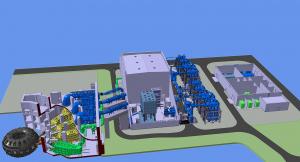"Outside and beyond anything"
In an empty plot on the ITER platform, preparatory works have started for the construction of two new buildings. From the outside, they will look like ordinary metal-frame structures, clad in ITER's signature mirror-like stainless steel and dark grey-lacquered metal. Inside the largest of the two however, nothing will be quite ordinary. In each of its two, mostly empty halls, Building 37 will accommodate a massive, shiny cube standing like a small house on eight 6-metre high stilts—a 1,000,000-volt high-voltage deck the likes of which does not exist outside the ITER world. These unique devices are the centrepieces of the electrical installation that will feed the ITER neutral beam injection system.
Neutral beam injection—the shooting of high-energy ions inside the plasma—is the workhorse of plasma heating techniques and has been implemented in most fusion devices since the mid-1980s. A neutral beam injector uses electrical voltage to accelerate particles to hair-raising speed before "neutralizing" them in order to penetrate the magnetic cage and communicate their kinetic energy to the plasma. In the European JET tokamak, the system delivers an electrical voltage on the order of 130,000 volts; in the Euro-Japanese JT-60SA, it will reach 500,000 volts for a few minutes; in ITER, it will need to sustain 1,000,000 volts (1MV) for durations of up to one hour.
"This is outside and beyond anything that's ever been done in terms of electrical engineering," explains Hans Decamps, the technical responsible officer for the ITER neutral beam power supply. "There are devices in weather research laboratories that generate ultra-high voltage for microseconds in order to modelize lightning, but no one before ITER needed to sustain such high tension for such a long duration."
Faced with a challenge of this magnitude, the ITER Organization and the European Domestic Energy Fusion for Energy, along with Japan and India, began working some ten years ago on a test facility comprising two full-scale mockups for the ITER neutral beam system: SPIDER for the ion source, and MITICA for the full injector including power supply.
In October of last year, megavolt power supply components procured by Japan and Europe were successfully tested in MITICA, laying the ground for transposition to the actual installation on the ITER platform.
Producing 1MV of direct current (DC) voltage and delivering it to the accelerating plaques inside the injectors requires an array of transformers, generators, rectifiers, inverters and other exotic electrical devices. Part of this equipment will be housed inside the more or less standard Neutral Beam Power Supply Building (Building 34) and in an exterior alley, while the two high-voltage decks*, each dedicated to one injector, will rise like alien structures in the halls of the high voltage building (Building 37).
"Simply stated, each high-voltage installation will be a copy-paste of MITICA," explains Lionel Lamberlin, the technical responsible officer for auxiliary buildings within the joint Europe-ITER Buildings and Infrastructure and Power Supply (BIPS) Project Team.
The nature of these electrical powerhouses has imposed severe constraints on the building's interior design. In order to avoid the generation of electrical arcs, the halls must not present sharp angles or protruding structures. Room temperature, humidity and dust level need to be carefully controlled at all times, and each deck is surrounded by a 5-metre-radius "exclusion zone." For obvious safety reasons, no one will be allowed into the building during operation.
Nuclear safety also imposes its stringent rules. The equipment itself is not nuclear safety related, but because the largest of the buildings is 25 metres tall and stands relatively close to the Tokamak Building (to which it is connected by bridges and transmission lines), resistance to a potential seismic event, to fire, and to outside explosion determines the building design. "What we need to prevent above all is the collapse of the building and the 'domino effect' on the protection important components (PIC) in the Tokamak Building," says Lamberlin.
Although the final design for the neutral beam power supply is far from complete, preparatory work has started on the construction site. Karst investigation is done and the digging of temporary excavations is ongoing. Once the upcoming manufacturing readiness review validates a final design, construction by Fusion for Energy contractor Demathieu-Bard will begin in earnest.
*ITER is planning two one-million-volt (MV) heating neutral beam injectors (and is making a space reservation for a possible third) as well as a smaller neutral beam line (100 kV) for diagnostic purposes.




